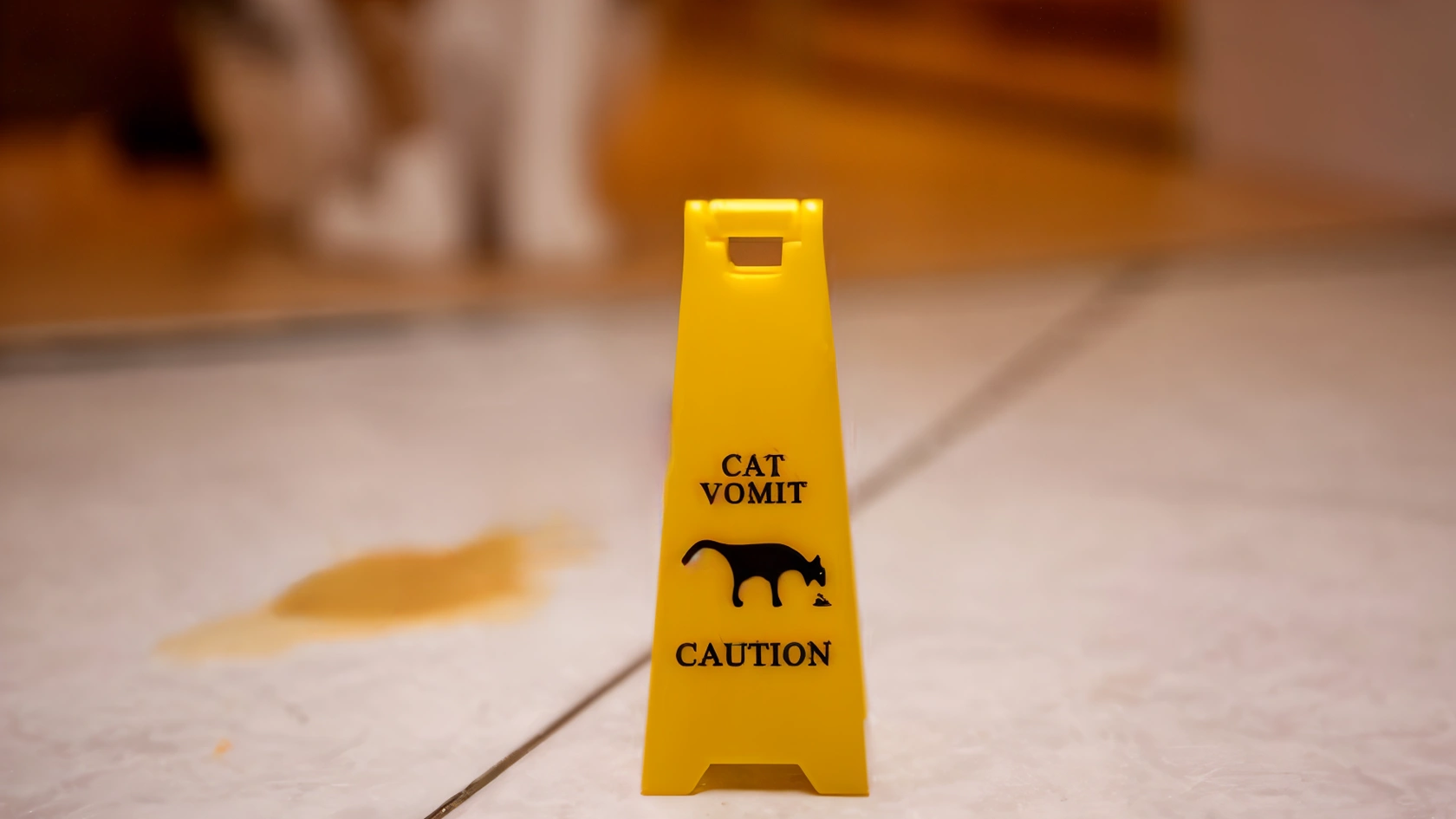TL; DR — My Cat Keeps Throwing Up but Seems Fine: What Frequent Cat Vomit Really Means
- Cats can vomit for many reasons, and sometimes they act completely normal afterwards, which can leave you wondering if it’s serious.
- Less serious causes include hairballs, eating too fast, undigested food, or mild food allergies.
- More serious causes might be inflammatory bowel disease, organ problems, parasites, metabolic disorders, or accidental ingestion of something harmful.
- The type of vomit—clear liquid, yellow bile, blood, or undigested food—can give clues about what your cat is experiencing.
- Changes in appetite, thirst, energy, hiding, or unusual behaviour are signs that vomiting in a cat could point to an underlying problem.
- Frequent or ongoing vomiting, particularly after your cat eats something inappropriate, is a sign that veterinary care is needed.
- Acting early can help your cat feel better, prevent more serious issues, and keep them happy and healthy.
If your cat is vomiting regularly or showing unusual signs, don’t wait—contact us. A quick check-up can make a huge difference and give you peace of mind that your cat is okay.
Ever notice your cat throw up but acting perfectly normal, like nothing happened? It can feel a little strange when your cat is throwing up yet still runs around, eats, or cuddles like usual. As cat owners, it’s normal to wonder if the cat’s vomiting is just a one-time thing or something that needs attention.
Sometimes a cat may vomit because they eat pretty fast, swallow a hairball, or bring up undigested food. Other times, it could be a sign of food allergies, bile from an empty stomach, or even a problem with the gastrointestinal tract. That’s why it’s important to tell the difference between simple, acute vomiting and more serious chronic vomiting.
Even if your cat seems fine afterwards, frequent vomiting is worth watching closely. The type of vomit—whether it’s yellow liquid, blood in the vomit, or just regurgitating dry food—can give clues about what’s going on. Keep reading to find out what different types of cat vomit could mean and when it’s time to seek veterinary care.
Why My Cat Keeps Throwing Up But Seems Fine: Common Causes of Vomiting in Cats
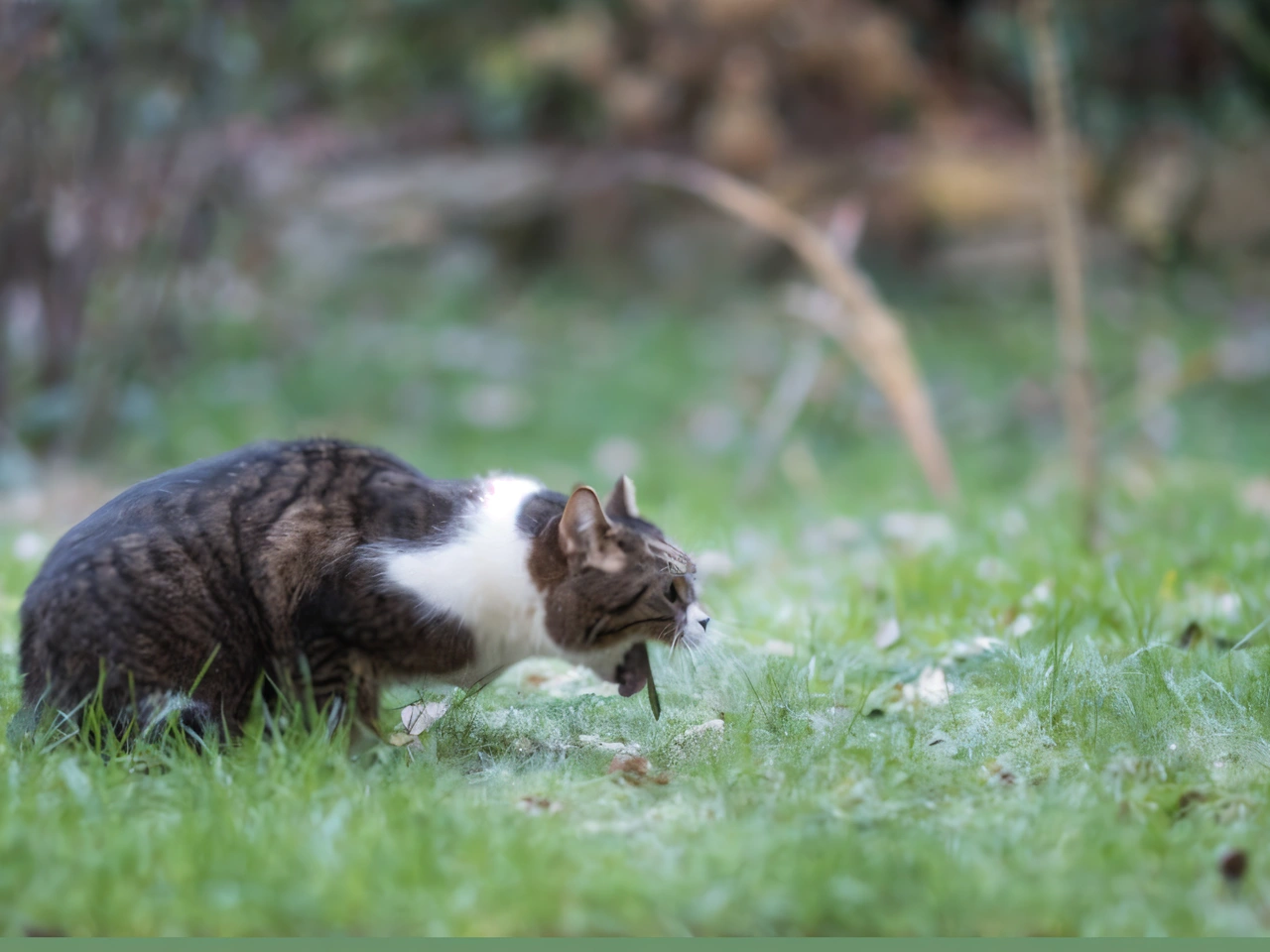
It can be worrying when your cat is vomiting, even if they seem fine afterwards. Cats throw up for many reasons, some harmless and some that need attention. Understanding the common causes can help you know when to relax and when to plan a visit to the vet.
Common & Less Serious Causes
These are everyday reasons why cats throw up. While usually not dangerous, they can make your cat uncomfortable and leave a mess to clean up. Paying attention to patterns and frequency can help you decide if any changes are needed in their care.
Hairballs
- Cats getting hairballs is very common, especially long-haired cats.
- Brushing your cat regularly can help reduce hair swallowing.
- Throwing up hairballs occasionally is normal, so don’t panic if you see a few.
Dietary Indiscretion
- Throwing up after eating can happen if your cat swallows dry food too fast.
- If your cat has ingested human food, spoiled food, or plants, this can also make them vomit.
- Cats with sensitive stomachs may throw up more often after diet changes.
Food Allergies or Intolerance
- Food allergies can cause a cat to vomit occasionally.
- Even foods your cat has eaten before can trigger vomiting if the formula changes.
Gastroenteritis and Gastric Irritation
- The cat is vomiting clear liquid or bile on an empty stomach sometimes.
- Occasional vomiting due to stress, minor illness, or medications is usually temporary.
Undigested Food
- The cat swallows food pretty fast, leading to the cat throwing up undigested pieces.
- Feeding smaller, frequent meals or using slow-feeder bowls can help.
Serious Causes
These causes are less common but may indicate significant health problems. If your cat is vomiting regularly or showing other symptoms, it’s important to seek veterinary care promptly. Understanding these causes can help you recognize warning signs early and get your cat the help they need.
Gastrointestinal Problems
- Cats with chronic vomiting may need a treatment plan from a veterinarian.
- Vomiting is happening regularly, sometimes with undigested food or bile.
Intestinal Parasites
- Cats will get parasites more often if they are kittens or spend time outdoors.
- Vomiting may be accompanied by diarrhea or blood, and deworming can help.
Organ Disease
- The cat shows other signs, like lethargy or not eating.
- Vomit looks like bile or partially digested food in some cases.
Metabolic Disorders
- The cat shows additional symptoms like increased thirst or weight loss.
- A veterinarian can create a treatment plan to manage these conditions.
Cancer
- Cat vomit could include blood or partially digested food.
- Cats with chronic vomiting and weight loss should see a veterinarian immediately.
Poisoning
- The cat has ingested human food, medications, or toxic chemicals.
- Vomiting is sudden and can include clear liquid or bile.
- Immediate veterinary care is essential.
Types of Cat Vomit and Cat Vomit Colour: What Your Cat’s Throw-Up Reveals
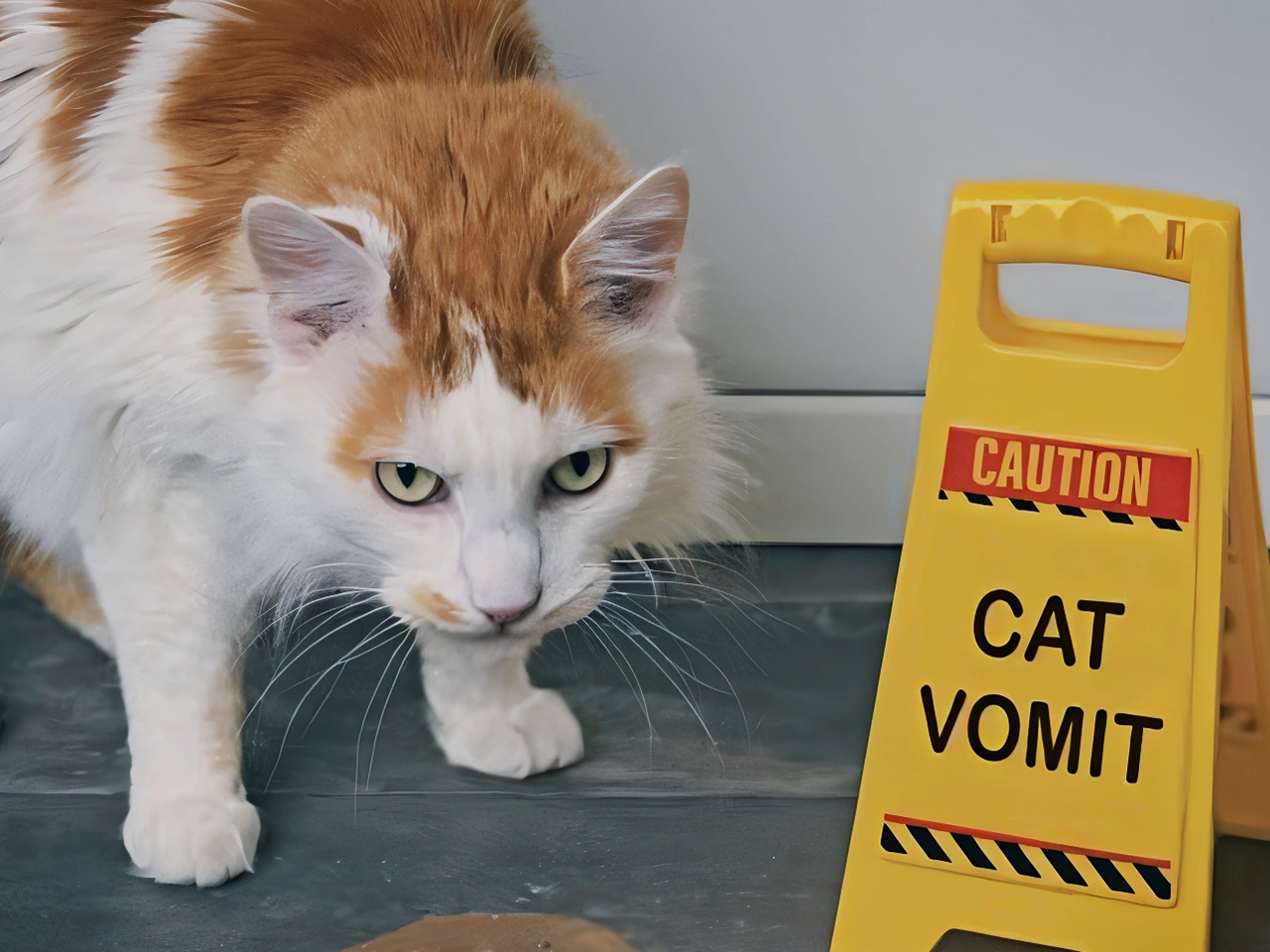
Not all cat vomit is the same, and the type of vomit can tell you a lot about what’s happening in your cat’s digestive tract. Even if your cat seems fine afterwards, paying attention to vomit can help you spot issues early and decide when to feed your cat differently or seek veterinary care.
Types of Cat Vomit
Cats will vomit for many reasons, and noticing the type of vomit is a sign that something may or may not be normal. Even though your cat seems fine, seeing the difference between hairballs, food, or liquid vomit helps you understand what your cat is experiencing.
Hairballs
- Cat throw-up often comes out as clumps of hair, sometimes with a little undigested food or clear liquid.
- Vomiting hairballs is normal for cats that groom themselves regularly.
- Brushing your cat regularly helps reduce hair ingestion and prevent frequent hairballs.
Undigested Food
- Cats may vomit undigested food or kibble, especially if the cat ate too fast or swallowed large chunks.
- A cat is regurgitating food soon after meals, and this is common in cats with sensitive stomachs.
- Feeding smaller portions or using a slow-feeder bowl can help cats throw up less undigested food.
Foamy/White Vomit
- Cats throwing up clear or frothy white vomit, often after an empty stomach.
- This type of vomit usually isn’t serious, and cats only throw it occasionally.
- Keeping track of foamy or white vomit helps notice patterns and know if veterinary care is needed.
Clear Liquid
- Cat throw-up can be watery or colourless, coming from stomach secretions.
- Cats only throw clear liquid sometimes, which usually doesn’t bother them.
- Observing when and how often your cat vomits clear liquid is useful for understanding their digestive health.
Bile
- Cats throwing up yellow liquid usually come from bile in the small intestine.
- This often happens when the cat ate a while ago or the stomach is empty.
- Frequent vomiting of bile is a sign that your cat may need veterinary care or adjustments to how you feed your cat.
Cat Vomit Colour & What It Means
The colour of cat vomit can reveal different things about your cat’s digestive system. Seeing vomit colour alongside your cat’s behaviour is a sign that helps determine whether your cat only throws up occasionally or needs a vet’s attention.
Clear/White
- Cats throwing up clear liquid or white may mean an empty stomach, stomach irritation, or excess stomach acid.
- Cats usually feel fine afterwards, but repeated episodes should be monitored.
Yellow/Green
- Cats throwing up yellow liquid usually indicates bile, either from an empty stomach or the cat ate plants.
- Cats can also vomit yellow liquid more regularly if there is irritation in the GI tract.
Brown
- Brown vomit could be partially digested food or a sign of bleeding in the upper digestive tract.
- Persistent brown vomit is a sign that cats need veterinary attention.
Red/Pink
- A cat regurgitating red or pink vomit contains fresh blood, often from ulcers, irritation, or trauma.
- This is a clear sign that cats need immediate veterinary care.
Black
- A cat's throw-up that is black shows digested blood, suggesting a serious problem like a bleeding ulcer or internal injury.
- This type of vomit is always a sign that cats need urgent veterinary attention.
Vomiting in Cats That Seem Fine: Behavioural Clues You Shouldn’t Ignore
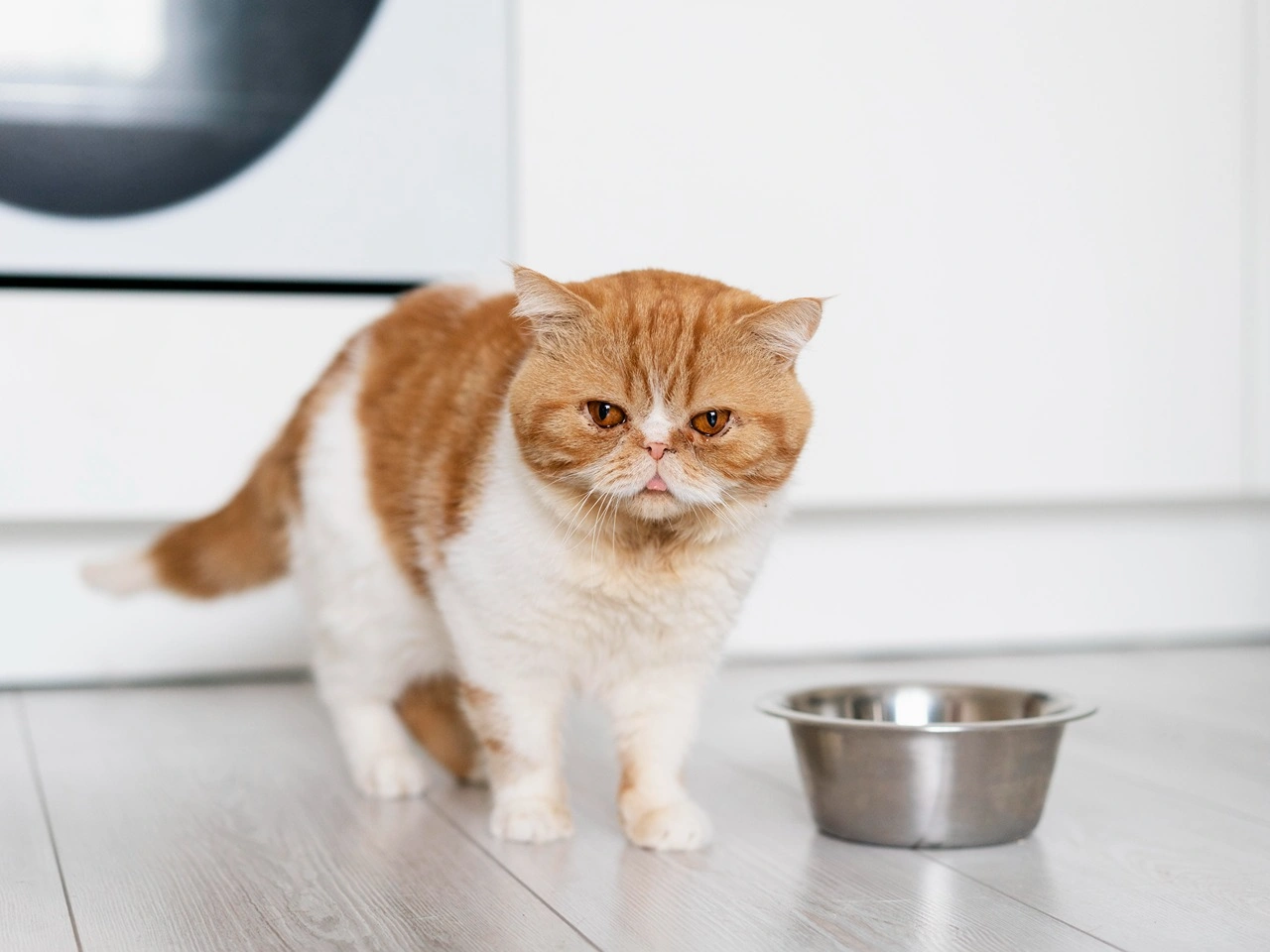
Sometimes your cat throws up but acts perfectly normal, which can leave you wondering if it’s serious. Even when your cat seems fine, vomiting can be a sign that your cat is experiencing discomfort or that something in their food may cause them to vomit. Paying attention to their behaviour helps you notice when veterinary care might be needed.
Changes in Appetite
A cat that normally eats with enthusiasm may suddenly eat less or skip meals. This could mean that the food is upsetting their stomach. Watching how your cat eats shows what your cat is experiencing.
Increased Thirst or Urination
Notice if your cat drinks more water or uses the litter box differently. Vomiting along with these changes means that the food or another condition could be causing them to vomit.
Hiding or Reduced Socialization
A cat that usually loves attention may start hiding or avoiding interaction. Even if your cat vomits but seems fine, this behaviour means your cat is either stressed or not feeling well.
Lethargy or Restlessness
A normally active cat may seem unusually tired or restless. This could mean that the food or another problem is making them uncomfortable, and your cat is either experiencing discomfort or something more serious.
Unusual Behaviours
Look for actions that seem out of character, like pawing at the mouth or subtle signs of discomfort. These behaviours mean that the cause of them to vomit may need a vet check.
Hiding Outside the Litter Box
If your cat hides outside the litter box, it can signal stress, bladder issues, or other health problems. Cat throw-up combined with this behaviour means that the food, water intake, or another condition could be causing them to vomit.
From Hairballs to Undigested Food: Triggers That Cause Your Cat to Vomit
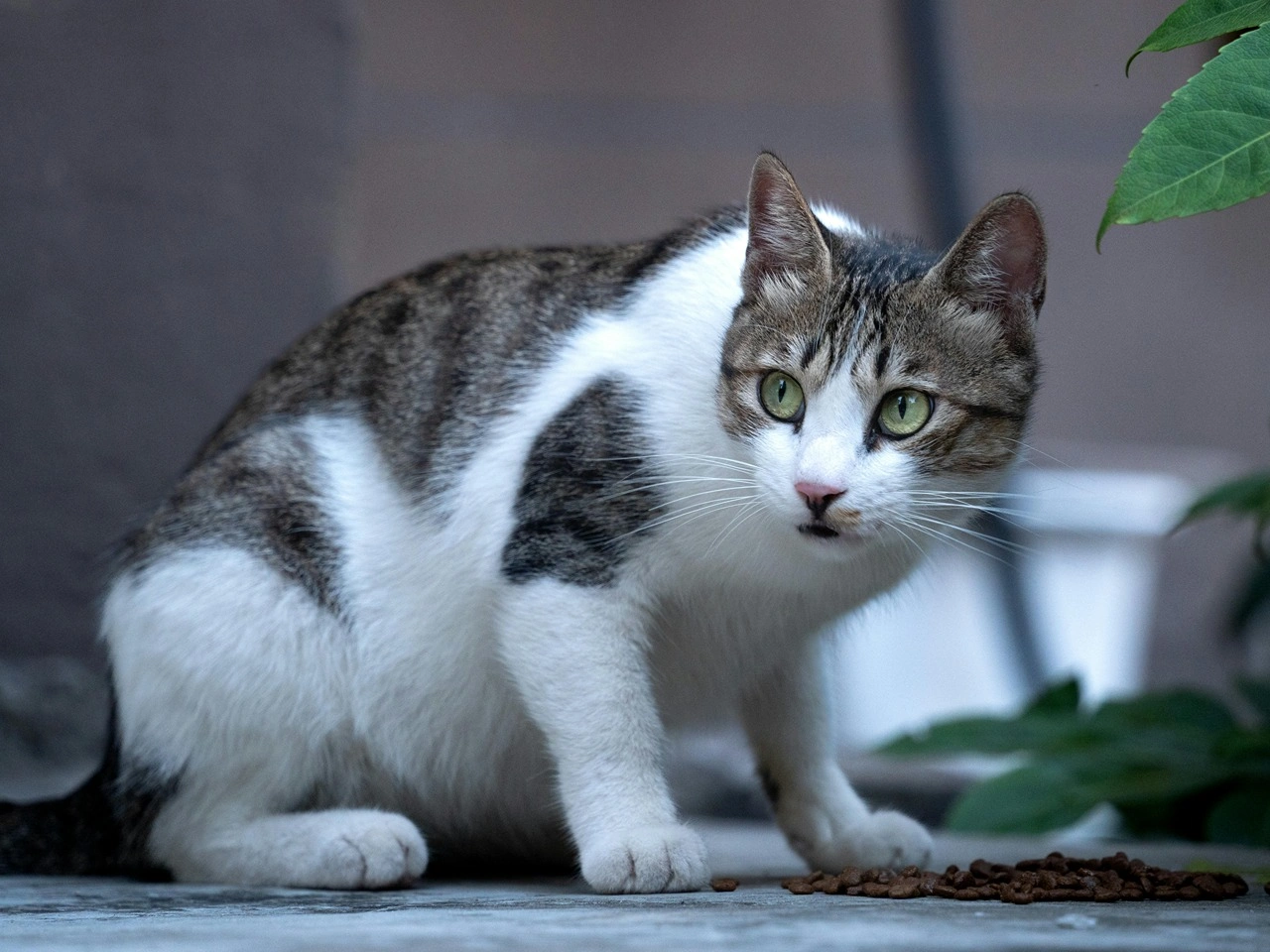
Cats can vomit for many reasons, and understanding the triggers helps you see what your cat is experiencing. Even if your cat seems fine afterwards, frequent vomiting may signal an issue.
Hairballs
Cats swallow hair while grooming, which can form clumps in their stomach. Vomiting hairballs is normal, but brushing your cat regularly reduces how often it happens.
Eating Too Quickly or Overeating
Eating too fast or too much at once can make a cat vomit shortly after meals. Feeding smaller portions or using a slow-feeder bowl helps calm their stomach.
Food Allergies or Intolerance
Some ingredients in cat food or human food can upset a cat’s stomach. Vomiting after meals may be a sign that the food is causing your cat discomfort.
Gastrointestinal Problems
Conditions like inflammatory bowel disease or blockages can make a cat vomit repeatedly. Even if your cat seems fine, it may be experiencing a more serious health issue that needs a vet.
Parasites and Organ Issues
Worms or illnesses affecting organs can trigger vomiting. Early detection keeps your cat healthier and more comfortable.
Stress, New Cat, or Environmental Changes
A new cat or changes at home can stress your cat and cause vomiting. Observing your cat closely helps you understand what your cat is experiencing and take steps to help them feel safe.
When It’s Time to Take Your Cat to the Veterinarian
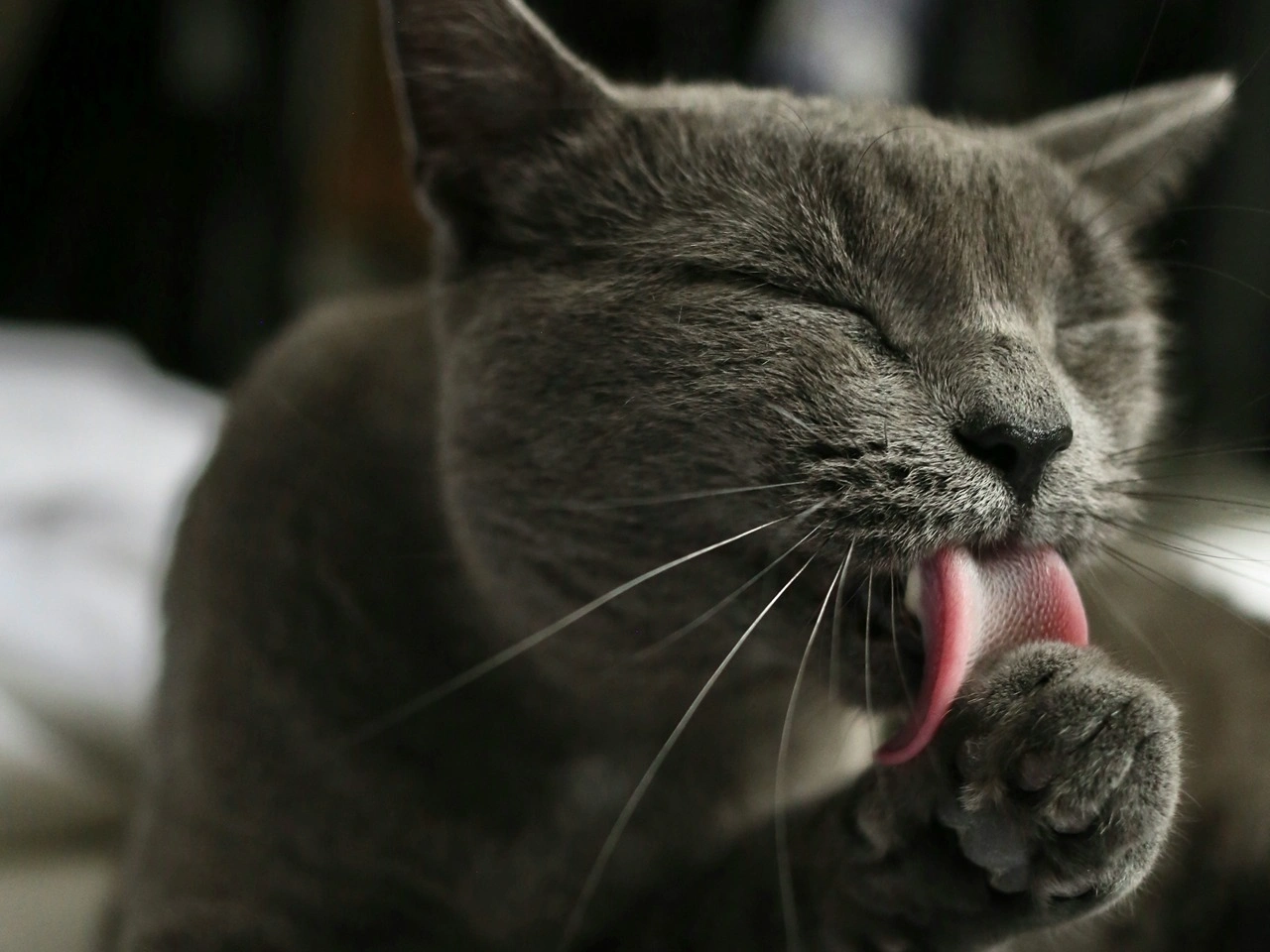
Sometimes vomiting in a cat is normal, but there are times when it means that it's time for your cat to see a veterinarian. Even if your cat seems fine after throwing up, repeated or severe vomiting can be a sign that your cat is experiencing something more serious. Paying attention to these signs helps you know when to act.
Frequent or Chronic Vomiting
If your cat regularly vomits or throws up more than a few times a week, it means that a treatment plan may be needed. Cats with chronic vomiting should be checked by a veterinarian to rule out conditions like inflammatory bowel disease or organ problems.
Vomit Looks Abnormal
Vomiting blood, a cat throwing up yellow liquid, or undigested food are all signals that your cat is experiencing more than a simple upset stomach. Seeing your cat vomit this type of throw-up is a clear reason to call a veterinarian.
Changes in Behaviour or Appetite
If your cat is not eating, hiding, or acting unusually after vomiting, it means that something is wrong. Even if the cat only throws occasionally, noticing these changes is a sign that a vet should evaluate them.
Vomiting After Ingesting Something Harmful
If your cat has ingested human food, toxic plants, or chemicals, vomiting is a warning that immediate veterinary care is needed. Acting quickly can prevent serious problems and help cats recover faster.
Other Red Flags
Signs like lethargy, dehydration, or vomiting on an empty stomach repeatedly also mean that professional attention is necessary for your cat. Seeing your cat display any of these symptoms is a strong signal to get veterinary help without delay.
Final Thoughts
Seeing your cat vomit can be worrying, especially when they seem perfectly fine afterwards. Sometimes it’s just hairballs, eating too fast, or a mild food sensitivity, but repeated or unusual vomiting could point to something more serious.
Paying attention to the type of vomit and how your cat is acting helps you understand what your cat is experiencing. Noticeable changes in appetite, energy, or behaviour are signs you shouldn’t ignore.
Keeping a close eye on your cat and seeking timely veterinary care can prevent small problems from turning into major health issues. If your cat is vomiting often or acting differently, a quick visit to the vet can make all the difference in keeping them happy and healthy.
Frequently Asked Questions
When is it necessary to take my cat to the vet if the cat is throwing up?
Vomiting can be normal sometimes, but it can also be a sign your cat needs help.
Frequent vomiting: If your cat throws up several times a week, it’s worth getting them checked.
Abnormal vomit: Blood, bile, or undigested food in the vomit could indicate a more serious problem.
Changes in behaviour: If your cat seems lethargic, hides more, or isn’t eating like usual, pay attention.
Vomiting after ingestion: Eating human food, toxic plants, or chemicals calls for immediate veterinary care.
Chronic conditions: Repeated vomiting may signal digestive issues, organ problems, or other health concerns that need a vet’s treatment plan.
Is it normal for cats to vomit after eating or when they are getting hairballs?
Sometimes vomiting is just part of being a cat, especially with meals or grooming.
After eating: Cats may throw up if they eat too fast or overeat. This is usually harmless for most cats.
Hairballs: Long-haired cats often vomit hairballs. Brushing your cat regularly can help reduce this type of vomiting.
Frequency: If your cat only throws up occasionally, there’s usually no need to worry.
When to monitor: Vomiting that becomes frequent or comes with other symptoms is a reason to see a vet.
What does acute vomiting mean, and when should I seek veterinary care?
Definition: Acute vomiting is sudden vomiting that happens once or a few times in a short period.
Common causes: It can result from eating something unusual, minor stomach irritation, or hairballs.
When to seek care: Repeated vomiting, blood in the vomit, refusal to eat, or lethargy mean it’s time for a vet visit.
Observation: Even if your cat seems fine afterward, acute vomiting can signal something more serious if it doesn’t stop quickly.
Should I be concerned if my cat is throwing up blood or vomiting on an empty stomach?
Red or black vomit: Vomit with blood, whether fresh or digested, can point to ulcers, trauma, or serious digestive problems.
Empty stomach vomiting: Throwing up bile or clear liquid when the stomach is empty can indicate irritation or more chronic digestive issues.
Veterinary care: Either of these signs means your cat should see a vet promptly, even if they act normal afterwards.
Other symptoms: Lethargy, loss of appetite, or unusual behaviour alongside vomiting increase the urgency for professional care.
How often is it normal for cats to throw up, and when does it become serious enough to take the cat to the vet?
Occasional vomiting: Hairballs, eating too fast, or mild dietary issues can cause a cat to throw up once in a while.
Frequent vomiting: Vomiting more than a few times a week, or regularly after meals, can signal a problem.
Persistent symptoms: Chronic vomiting, vomiting with blood or bile, or vomiting along with changes in appetite or behaviour are serious.
Veterinary visit: Any combination of frequent vomiting and abnormal symptoms means it’s time to consult a veterinarian to keep your cat healthy and comfortable.

